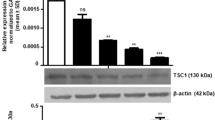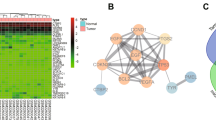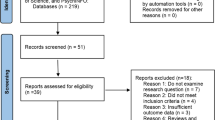Abstract
Aberrant expression of microRNAs (miRNAs) has been involved in the development and progression of malignancy. MicroRNA-9 (miR-9) has been confirmed to be underexpressed in many types of cancers. However, the relationship between miR-9 and the Wnt/β-catenin signaling pathway in oral squamous cell carcinoma (OSCC) remains largely unknown. Here we showed that the miR-9 was underexpressed in patients with OSCC and several OSCC cell lines. Lentivirus-mediated miR-9 overexpression in highly aggressive (Tca8113 and SCC-9) tumor cells significantly inhibited proliferation of the two cell lines in vitro and in vivo. Furthermore, we found that the CXC chemokine receptor 4 (CXCR4) gene was a direct target of miR-9. RNA interference silencing of CXCR4 proved that miR-9 underexpression led to constitutive activation of β-catenin through activation of CXCR4 expression in OSCC cells. Finally, we also analyzed the possible relationship between miR-9 and the genes downstream of the Wnt/β-catenin pathway in OSCC development and progression. These results provide new evidence of miR-9 as a promising tumor gene therapeutic target for OSCC patients.
This is a preview of subscription content, access via your institution
Access options
Subscribe to this journal
Receive 50 print issues and online access
$259.00 per year
only $5.18 per issue
Buy this article
- Purchase on Springer Link
- Instant access to full article PDF
Prices may be subject to local taxes which are calculated during checkout






Similar content being viewed by others
References
Kademani D . Oral cancer. Mayo Clin Proc 2007; 82: 878–887.
Petersen PE . The World Oral Health Report 2003: continuous improvement of oral health in the 21st century- the approach of WHO Global Programme. Commun Dent Oral Epidemiol 2003; 31: 3–23.
Yu T, Wang XY, Gong RG, Li A, Yang S, Cao YT et al. The expression profile of microRNAs in a model of 7,12-dimethyl-benz[a]anthrance-induced oral carcinogenesis in Syrian hamster. J Exp Clin Cancer Res 2009; 13: 64.
Kessler P, Grabenbauer G, Leher A, Bloch-Birkholz A, Vairaktaris E, Neukam FW . Neoadjuvant and adjuvant therapy in patients with oral squamous cell carcinoma: long-term survival in a prospective, non-randomized study. Br J Oral Maxillofac Surg 2008; 46: 1–5.
Hu J, He Y, Yan M, Zhu C, Ye W, Zhu H et al. Dose dependent activation of retinoic acid-inducible gene-I promotes both proliferation and apoptosis signals in human head and neck squamous cell carcinoma. PLoS One 2013; 8: e58273.
Uchida F, Uzawa K, Kasamatsu A, Takatori H, Sakamoto Y, Ogawara K et al. Overexpression of CDCA2 in human squamous cell carcinoma: correlation with prevention of G1 phase arrest and apoptosis. PLoS One 2013; 8: e56381.
Ambros V . The functions of animal microRNAs. Nature 2004; 431: 350–355.
Bartel DP . MicroRNAs: genomics, biogenesis, mechanism and function. Cell 2004; 116: 281–297.
Calin GA, Croce CM . MicroRNA-cancer connection: the beginning of a new tale. Cancer Res 2006; 66: 7390–7394.
Bandyopadhyay S, Mitra R, Maulik U, Zhang MQ . Development of the human cancer microRNA network. Silence 2010; 1: 6.
Selcuklu SD, Donoghue MTA, Spillane C . MiR-21 as a key regulator of oncogenic processes. Biochem Soc T 2009; 37: 918–925.
Li JS, Huang HZ, Sun LJ, Yang M, Pan CB, Chen WL et al. MiR-21 indicates poor prognosis in tongue squamous cell carcinomas as an apoptosis inhibitor. Clin Cancer Res 2009; 15: 3998–4008.
Avissar M, McClean MD, Kelsey KT, Marsit CJ . MicroRNA expression in head and neck cancer associates with alcohol consumption and survival. Carcinogenesis 2009; 30: 2059–2063.
Wong TS, Liu XB, Ho ACW, Yuen APW, Ng RWM, Wei WI . Identification of pyruvate kinase type M2 as potential oncoprotein in squamous cell carcinoma of tongue through microRNA profiling. Int J Cancer 2008; 123: 251–257.
Jiang L, Liu XQ, Kolokythas A, Yu JS, Wang AX, Heidbreder CE et al. Downregulation of the Rho GTPase signaling pathway is involved in the microRNA-138-mediated inhibition of cell migration and invasion in tongue squamous cell carcinoma. Int J Cancer 2010; 127: 505–512.
Gao F, Zhao ZL, Zhao WT, Fan QR, Wang SC, Li J et al. miR-9 modulates the expression of interferon-regulated genes and MHC class I molecules in human nasopharyngeal carcinoma cells. Biochem Biophys Res Commun 2013; 431: 610–616.
Bandres E, Agirre X, Bitarte N, Ramirez N, Zarate R, Roman-Gomez J et al. Epigenetic regulation of microRNA expression in colorectal cancer. Int J Cancer 2009; 125: 2737–2743.
Selcuklu SD, Donoghue MT, Rehmet K, de Souza Gomes M, Fort A, Kovvuru P et al. MicroRNA-9 inhibition of cell proliferation and identification of novel miR-9 targets by transcriptome profiling in breast cancer cells. J Biol Chem 2012; 287: 29516–29528.
Liu S, Kumar SM, Lu H, Liu A, Yang R, Pushparajan A et al. MicroRNA-9 up-regulates E-cadherin through inhibition of NF-κB1-Snail1 pathway in melanoma. J Pathol 2012; 226: 61–72.
Sun Z, Han Q, Zhou N, Wang S, Lu S, Bai C et al. MicroRNA-9 enhances migration and invasion through KLF17 in hepatocellular carcinoma. Mol Oncol 2013; S1574-7891: 00068–00069.
Nass D, Rosenwald S, Meiri E, Gilad S, Tabibian-Keissar H, Schlosberg A et al. MiR-92b and miR-9/9* are specifically expressed in brain primary tumors and can be used to differentiate primary from metastatic brain tumors. Brain Pathol 2009; 19: 375–383.
Leucci E, Zriwil A, Gregersen LH, Jensen KT, Obad S, Bellan C et al. Inhibition of miR-9 de-represses HuR and DICER1 and impairs Hodgkin lymphoma tumour outgrowth in vivo. Oncogene 2012; 31: 5081–5089.
Teicher BA, Fricker SP . CXCL12 (SDF-1)/CXCR4 pathway in cancer. Clin. Cancer Res 2010; 16: 2927–2931.
Burger JA, Kipps TJ . CXCR4: a key receptor in the crosstalk between tumor cells and their microenvironment. Blood 2006; 107: 1761–1767.
Janda CY, Waghray D, Levin AM, Thomas C, Garcia KC . Structural basis of Wnt recognition by Frizzled. Science 2012; 337: 59–64.
Garzon R, Calin GA, Croce CM . MicroRNAs in Cancer. Annu Rev Med 2009; 60: 167–179.
Garzon R, Marcucci G, Croce CM . Targeting microRNAs in cancer: rationale, strategies and challenges. Nat Rev Drug Discov 2010; 9: 775–789.
Esquela-Kerscher A, Slack FJ . Oncomirs - microRNAs with a role in cancer. Nat Rev Cancer 2006; 6: 259–269.
Liu N, Sun Q, Chen J, Li J, Zeng Y, Zhai S et al. MicroRNA-9 suppresses uveal melanoma cell migration and invasion through the NF-κB1 pathway. Oncol Rep 2012; 28: 961–968.
Jing L, Jia Y, Lu J, Han R, Li J, Wang S et al. MicroRNA-9 promotes differentiation of mouse bone mesenchymal stem cells into neurons by Notch signaling. Neuroreport 2011; 22: 206–211.
Iorio MV, Ferracin M, Liu CG, Veronese A, Spizzo R, Sabbioni S et al. MicroRNA gene expression deregulation in human breast cancer. Cancer Res 2005; 65: 7065–7070.
Lehmann U, Hasemeier B, Christgen M, Müller M, Römermann D, Länger F et al. Epigenetic inactivation of microRNA gene hsa-miR-9-1 in human breast cancer. J Pathol 2008; 214: 17–24.
Nie K, Gomez M, Landgraf P, Garcia JF, Liu Y, Tan LH et al. MicroRNA-mediated downregulation of PRDM1/Blimp-1 in Hodgkin/Reed-Sternberg cells: a potential pathogenetic lesion in Hodgkin lymphomas. Am J Pathol 2008; 173: 242–252.
Rotkrua P, Akiyama Y, Hashimoto Y, Otsubo T, Yuasa1 Y . MiR-9 downregulates CDX2 expression in gastric cancer cells. Int J Cancer 2011; 129: 2611–2620.
Omura N, Li CP, Li A, Hong SM, Walter K, Jimeno A et al. Genomewide profiling at methylated promoters in pancreatic adenocarcinoma. Cancer Biol Ther 2008; 7: 1146–1156.
Luo H, Zhang H, Zhang Z, Zhang X, Ning B, Guo J et al. Downregulated miR-9 and miR-433 in human gastric carcinoma. J Exp Clin Cancer Res 2009; 28: 82.
Laios A, O'Toole S, Flavin R, Martin C, Kelly L, Ring M et al. Potential role of miR-9 and miR-223 in recurrent ovarian cancer. Mol Cancer 2008; 7: 35.
Caruz A, Samsom M, Alonso JM, Alcami J, Baleux F, Virelizier JL et al. Genomic organization and promoter characterization of human cxcr4 gene. FEBS Lett 1998; 426: 271–278.
Balkwill F . Cancer and the chemokine network. Nat Rev Cancer 2004; 4: 540–550.
Peifer M, Polakis P . Wnt signaling in oncogenesis and embryogenesis-a look outside the nucleus. Science 2000; 287: 1606–1609.
Lowy AM, Fenoglio-Preiser C, Kim OJ, Kordich J, Gomez A, Knight J et al. Dysregulation of beta-catenin expression correlates with tumor differentiation in pancreatic duct adenocarcinoma. Ann Surg Oncol 2003; 10: 284–290.
Al-Aynati MM, Radulovich N, Riddell RH, Tsao MS . Epithelialcadherin and beta-catenin expression changes in pancreatic intraepithelial neoplasia. Clin Cancer Res 2004; 10: 1235–1240.
Jin Z, Zhao C, Han X, Han Y . Wnt5a promotes ewing sarcoma cell migration through upregulating CXCR4 expression. BMC Cancer 2012; 12: 480.
Choe Y, Pleasure SJ . Wnt signaling regulates intermediate precursor production in the postnatal dentate gyrus by regulating CXCR4 expression. Dev Neurosci 2012; 34: 502–514.
Fracalossi AC, Silva Mde S, Oshima CT, Ribeiro DA . Wnt/beta-catenin signalling pathway following rat tongue carcinogenesis induced by 4-nitroquinoline 1-oxide. Exp Mol Pathol 2010; 88: 176–183.
Farr GH, Ferkey DM, Yost C, Pierce SB, Weaver C, Kimelman D . Interaction among GSK-3, GBP, axin, and APC in Xenopus axis specification. J Cell Biol 2000; 148: 691–702.
Chiyomaru T, Enokida H, Tatarano S, Kawahara K, Uchida Y, Nishiyama K et al. miR-145 and miR-133a function as tumour suppressors and directly regulate FSCN1 expression in bladder cancer. Br J Cancer 2010; 102: 883–891.
Author information
Authors and Affiliations
Corresponding authors
Ethics declarations
Competing interests
The authors declare no conflict of interest.
Additional information
Supplementary Information accompanies this paper on the Oncogene website
Rights and permissions
About this article
Cite this article
Yu, T., Liu, K., Wu, Y. et al. MicroRNA-9 inhibits the proliferation of oral squamous cell carcinoma cells by suppressing expression of CXCR4 via the Wnt/β-catenin signaling pathway. Oncogene 33, 5017–5027 (2014). https://doi.org/10.1038/onc.2013.448
Received:
Revised:
Accepted:
Published:
Issue Date:
DOI: https://doi.org/10.1038/onc.2013.448
Keywords
This article is cited by
-
Role of senescent tumor cells in building a cytokine shield in the tumor microenvironment: mathematical modeling
Journal of Mathematical Biology (2023)
-
Suppression of exosomal hsa_circ_0001005 eliminates the Vemurafenib resistance of melanoma
Journal of Cancer Research and Clinical Oncology (2023)
-
MicroRNA-143 act as a tumor suppressor microRNA in human lung cancer cells by inhibiting cell proliferation, invasion, and migration
Molecular Biology Reports (2022)
-
The interplay of cytokine signaling and non-coding RNAs in head and neck squamous cell carcinoma pathobiology
Molecular Biology Reports (2022)
-
Overexpression of miRNA-9 enhances galectin-3 levels in oral cavity cancers
Molecular Biology Reports (2021)



